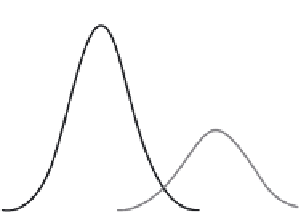Information Technology Reference
In-Depth Information
Majority-class distribution
Minority-class distribution
Virtual instances created by SMOTE
Virtual instances created by V
IRTUAL
M
arg
in
M
argi
n
(a)
(b)
Figure 6.7
Comparison of oversampling the minority class with SMOTE and VIRTUAL.
(a) Oversampling with SMOTE and (b) oversampling with VIRTUAL.
number of virtual instances created for a real positive support vector in each
iteration,
|
SV (
+
)
|
is the number of positive support vectors, and
C
is the cost of
finding k nearest neighbors. The computation complexity of SMOTE is
O(
X
R
·
v
)
, where
X
R
is the number of positive training instances.
depends on the
approach for finding
k
nearest neighbors. The naive implementation searches all
N
training instances for the nearest neighbors and thus
·
C
C
C
=
kN
. Using advanced
data structure such as kd-tree,
C
=
k
log
N
.Since
|
SV (
+
)
|
is typically much less
than
X
R
, VIRTUAL incurs lower computation overhead than SMOTE. Also,
with fewer virtual instances created, the learner is less burdened with VIRTUAL.
We demonstrate with empirical results that the virtual instances created with
VIRTUAL are more informative and the prediction performance is also improved.
6.4.3 Experiments
We conduct a series of experiments on Reuters-21578 and four UCI datasets
to demonstrate the efficacy of VIRTUAL. The characteristics of the datasets are
detailed in [22]. We compare VIRTUAL with two systems, AL and SMOTE. AL
adopts the traditional AL strategy without preprocessing or creating any virtual
instances during learning. SMOTE, on the other hand, preprocesses the data by
creating virtual instances before training and uses RS in learning. Experiments
elicit the advantages of adaptive virtual sample creation in VIRTUAL.
Figures 6.8 and 6.9 provide details on the behavior of the three algorithms,
SMOTE, AL, and VIRTUAL. For the Reuters datasets (Fig. 6.9), note that in all
the 10 categories, VIRTUAL outperforms AL in g-means metric after saturation.
The difference in performance is most pronounced in the more imbalanced cate-
gories, for example,
corn
,
interest
,and
ship
. In the less imbalanced datasets such
as
acq
and
earn
, the difference in
g
-means of both methods is less noticeable.
The
g
-means of SMOTE converges much slower than both AL and VIRTUAL.

















Search WWH ::

Custom Search